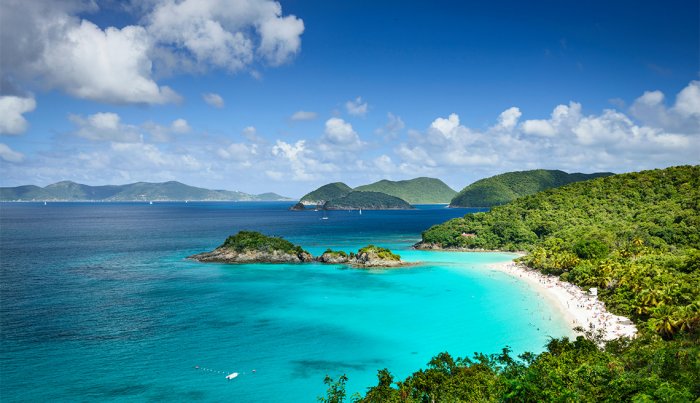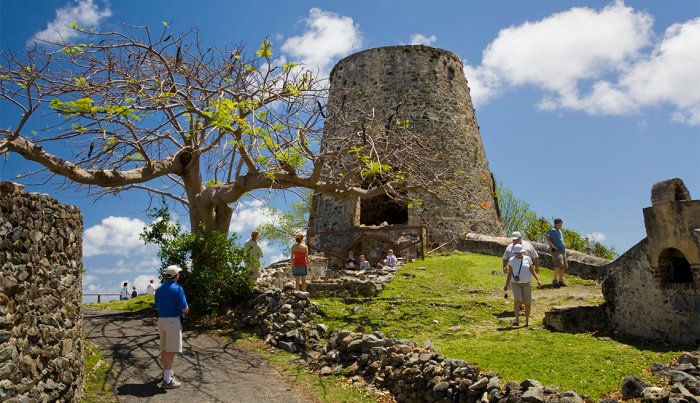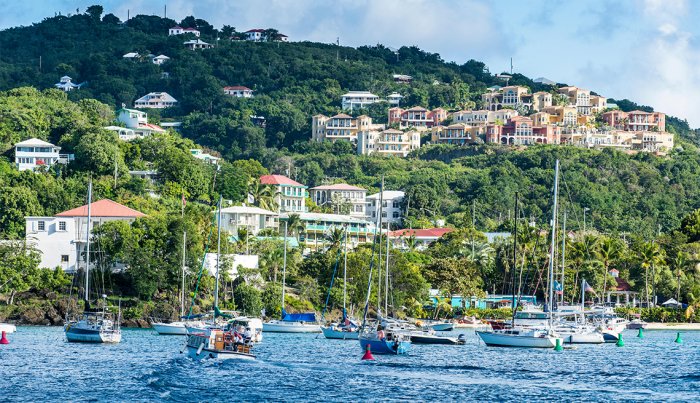No passport needed for Americans visiting this gorgeous tourist haven on St. John
CRUZ BAY — With idyllic, undeveloped white-sand beaches and sea turtles, eagle rays and schools of multicolored fish parading just a short swim from shore, Virgin Islands National Park (VINP) is a paradise on Earth — specifically on St. John.
Billionaire Laurance Rockefeller thought this small, 20-square-mile American-Caribbean island was so beautiful he bought nearly 60 percent of St. John in 1952. Then he donated the land to the federal government in 1956 with the stipulation it become a national park for all to enjoy for generations to come.
Another big name mesmerized by the island, country music star Kenny Chesney, has owned a home here for years that was destroyed when Hurricane Irma swept across the isle in September 2017. The widespread devastation caused by Irma prompted Chesney to start a foundation that raised funds to help rebuild the isle and park. He has often sung of the joys of St. John beach life: “From this chair I’ve caught a few fish and some rays, and I’ve watched boats sail in and out of Cinnamon Bay … Been here about a month, not doing much at all, man it’s hard to get bored when you’re having a ball.”
St John and VINP aren’t just for sun, sand and rum cocktails, though. “People come here for the beaches and the water, but the island has such a rich history, you’d be missing out if you didn’t tour at least one historical site,” says Jenn Manes, owner of Explore STJ tours, a local company taking visitors on combination beach and culture tours. A surprising number of historic sites are hidden in the park’s jungled, mountainous terrain: from ancient petroglyphs Taino peoples carved in rocks to ruins of once-mighty sugar plantations, including the recently commemorated “Road to Freedom” trail memorializing the slaves who toiled there.
While the national park and St. John have bounced back well from Hurricane Irma and then Hurricane Maria just two weeks later, recovery efforts are ongoing. The heavily damaged, Rockefeller-founded Caneel Bay Resort within the park still awaits redevelopment, and many trails remain denuded, their large shade trees felled by the hurricanes. But that shouldn’t stop you from visiting: Green once again blankets park hillsides, the waters still shimmer in shades of vivid blue, and the park’s beautiful Cinnamon Bay Beach and Campground has reopened.
VINP can be visited as a day trip from St. Thomas (where plentiful lodging options come cheaper), but to best experience the park plan on spending a few days on St. John to walk the park’s hiking trails, visit its historic sites and, of course, relax on its beaches.
COVID-19-related requirements
Visitors must submit documentation of COVID-19 vaccination through the USVI travel screening portal. If not fully vaccinated or unvaccinated for COVID-19, you will need to to submit proof of a negative COVID-19 test taken no more than five days before arrival. Check the Centers for Disease Control and Prevention and USVI travel websites for updates.
When to go
The best time of year to visit VINP is from March through June, with less rainfall and slightly cooler temperatures (with highs in the mid 80s instead of the 90s) and fewer visitors. The island’s wet season from July to October comes with high humidity and the threat of hurricanes, but barring extreme events, daily rains pass quickly. High season covers November through February, with larger crowds and less availability for lodging and transport.
Getting there and upon arrival
Most visitors to the USVI fly into St. Thomas, about a two-and-a-half-hour flight southeast from Miami. U.S. citizens don’t need a passport for entry, just a driver’s license or other government ID, but having one can help with the entry process. To get from St. Thomas to St. John, take a 20-minute ferry ride from Red Hook Harbor, on the island’s eastern edge, to Cruz Bay on St. John’s western side. Both passenger and car ferries depart frequently.
When you arrive on St. John, look for the harborside VINP Visitor Center at Cruz Bay. You can grab free maps or purchase guidebooks there, check out history and nature displays, and get advice from the information officer. On the trailhead behind the center, you can begin exploring the park with a hike to beautiful Honeymoon Beach just over a mile away on an often hot but fairly easy trail.
Getting around
Jeep rental is the best way to get around St. John if you’re staying for multiple days, as the local taxis can be slow to respond for ride requests and are expensive. They charge a flat fee, usually $10-$14 per person, so a family of four can pay $80 or more (plus bag fees or other surcharges) for a short round trip, and the driver may stop for other passengers. Be sure to get a price quote before entering any taxi. Jeeps are useful for navigating St. John’s steep winding roads (and home driveways), but parking is at a premium, so arrive early at beaches, trailheads, historic sites and in town for dinner. And always remember, traffic drives on the left side of the road in the USVI. If you opt for a day trip, consider touring the park and isle with a company such as STJ Tours. You’ll maximize your time, as you’ll get a personalized overview of the island, learn some history and not have to bother with the driving.
What to pack
Take along plenty of sunscreen, and be sure to use it while sailing or beachside, where cooling offshore breezes can fool you into thinking the sun isn’t that strong — but it is. The USVI officially has a ban on nonreef-safe sunscreens, so bring a brand that’s zinc oxide-based (usually with a “reef safe” label on it). You’ll need bug repellent, too. The notorious native no-see-ums will leave unprotected flesh with itchy bites. Also, wear lightweight long pants and shirts in early morning and evening when insects are most active.
Note that regular U.S. cellphone service works well on the island, without added surcharges. The only quirk: On St. John’s eastern edge, close to the British Virgin Islands, phones may connect to a European carrier, possibly incurring added charges.
Where to stay and eat
There’s no lodging on official National Park lands except the Cinnamon Bay campgrounds — recently reopened after renovations with four new shared bathhouses, 31 tent sites (with wood tent platforms and picnic benches), 50 “eco-tents” (pre-fab canvas cabins with beds and electricity) that accommodate from two to four people, and 40 cottage units in seven buildings. The Rain Tree Café serves breakfast and dinner, and a food truck by the beach brings in lunches. Buy basic grocery items and to-go foods at the camp store.
Beyond the campgrounds, the park’s 1956 formation left many “in-holdings” of private property remaining within park boundaries. Many now function as vacation rentals — some beachside or mountaintop luxury homes with pools, others more modest retreats. Even more rental options sit just outside park boundaries, so scan Airbnb, VRBO and local sites to find a location and pricing that’s right for you.
Typical hotels and resort options are limited, the main one being the Westin St. John, a sprawling 252-room time-share property near Cruz Bay that’s available for nightly rentals. After settling into studios or villas with up to three bedrooms, guests enjoy myriad resort amenities, including a pool and small beach with equipment rentals, along with a beachside grill and a deli.
The town of Cruz Bay is St. John’s main hub, with a few square blocks of restaurants, bars and shops. For a relaxed, family-friendly dining spot, start your day at Cruz Bay Landing, sinking your teeth into its excellent Crab Cake Bennie — crispy local crab topped with a poached egg slathered with savory hollandaise sauce. Come dinnertime, it pairs live music with a menu starring Caribbean lobster. Across the island in quiet Coral Bay, rub elbows with visiting yachters and local beach bums at Skinny Legs, a legendary bar and grill where you can grab fish and chips and trade pirate stories while watching sports on TV.
Things to do
Beaches: VINP is rightfully famous for its white-sand beaches stretching along calm, protected bays filled with sea life. Visit the north part of the park to see the best of them and dip your toes in the waters at Hawksnest, Trunk, Cinnamon and Maho bays, going west to east on the North Shore Road from Cruz Bay. Arrive early to grab a parking spot and a semi-shady spot in the sand, then spend the day soaking in the sun and snorkeling in the Caribbean Sea.
At Maho Bay, the most developed, you’ll find an array of food trucks, souvenir stands and small bars across the street from the beach. At Trunk Bay, the $5 admission fee gives you access to the beach and facilities, including an equipment rental operation, bathrooms and a snack bar. Just offshore, snorkel along the “Underwater Trail,” with submerged plaques describing area sea life. Closer to Cruz Bay, VINP’s sometimes crowded Honeymoon Beach has its own set of beachside vendors and food trucks, while nearby Salomon Beach provides a more serene escape.
VINP extends out into the sea to protect the coral reefs around the island, spectacular spots for snorkelers and scuba divers to spot some of the 400 species of fish who make these waters their home. Sea turtles abound, especially in Maho Bay, and placid eagle rays often flap close to shore. “It’s like someone dropped you into an aquarium, it’s so spectacular,” says Laurel Brannick, the park’s supervisor of interpretation. “If you come to the park and don’t look underwater, it’s like going to the Grand Canyon and not looking down.”
Hike: Walk some of the park’s more than 20 trails to access spectacular viewpoints, explore historical sites and see wildlife, including fluttering yellow bananaquits (the official bird of the USVI), scurrying lizards, creeping hermit crabs and even wandering wild donkeys. Given the hot and humid climate, be sure to bring plenty of water, use insect repellent and sunscreen, and wear a hat to protect against the sun on sometimes exposed trails. The Friends of Virgin Islands National Park nonprofit group may be leading hikes, conditions permitting (its website offers lots of useful information for visitors, too).
VINP features some flat hiking paths accessible to most anyone. The Lind Point Trail, which begins directly behind the park’s Cruz Bay Visitor Center, leads you on a fairly easy path a mile to the popular Honeymoon Beach. If you’re motivated, continue uphill to Lind Point Overlook for sweeping views of Cruz Bay. The Cinnamon Bay Trail on the island’s northern side begins with a flat half-mile signed, interpretive path through the ruins of the Cinnamon Bay Plantation — the first 500 feet paved and wheelchair-accessible. A few hundred feet uphill from North Shore Road, hop out of your Jeep for an easy roadside trail to Peace Hill; you’ll see the ruins of a stone windmill and admire sweeping views of the Caribbean and VINP’s best beaches.
For the adventurous, the park’s signature Reef Bay-Petroglyph Trail follows a strenuous path into history and beauty. Take the 2.2-mile Reef Bay Trail covering 900 feet of elevation through both thick jungle and sun-exposed segments to discover sugar-estate ruins and the scenic beach at Reef Bay. Midway on the trail, take a half-mile-long spur on Petroglyph Trail to see the mysterious symbols the Taino peoples carved into rocks hundreds of years ago.
Sail: Whether by small sailboat, sturdy catamaran or luxury power yacht, do experience VINP by sea — the only way to reach the park’s many small cays, islets and reefs, and remote beaches. Go on snorkeling expeditions, a sunset cruise, or just hop from peaceful beach to peaceful beach by chartering a boat or joining a group tour with company such as Cruz Bay Watersports. You can also do multiday charters with Moorings, which bases a fleet of powerboats and sailboats in St. Thomas. The national park rents limited spots for boats to moor near the popular beaches.
Explore history: Don’t neglect the rich history preserved within VINP. See the indigenous Taino tribes’ rock carvings on Petroglyph Trail and archaeological finds at the visitor center. Explore the remnants of the Danish colonists who left a sprawling set of ruins from their extensive sugar plantations, most notably the stone windmills that can be seen across the park. Tour the remains of the Annaberg Plantation in northern VINP, with signs providing history of the windmill, sugar factory, distillery and homesites. Find the gardens just below the windmill to meet local landscaper Charles Jackson, who gives informal talks on park flora most weekdays between 10 a.m. and 2 p.m. — and even gives out samples of his fresh, sweet sugar cane and mango grown there.
A painful part of St John’s past concerns the generations of slave labor who cleared the land and worked the sugar plantations, and the brutal repression of these Blacks’ freedom and attempted uprisings. See this history in the remains of the humble slave quarters at Annaberg, as well as just down the hill at the nearby Leinster Bay shoreline along the recently certified “Road to Freedom” Trail, part of a national set of Underground Railroad sites. Some slaves seeking escape to the tantalizingly close British Virgin Islands, which abolished slavery 12 years before the then-Danish Virgin Islands, used this trail to launch stolen boats or to start swimming the 1.2 miles to the British shores. Above the trail, visit the remains of a looming hilltop guardhouse for a stark reminder of those troubled times.
Beyond the park
St. John’s East End, just beyond park boundaries, is the place to go to escape crowds and rent jet skis and other powered watercraft not allowed at park beaches. Try the glass-bottomed kayaks and motorized sea scooters to explore the clear waters at Saltwell Beach in Hansen Bay, where a local family hosts parking ($5), a small snack bar and souvenir stand.
Bill Fink is an award-winning travel writer who has covered cultural travel for Lonely Planet, Frommer’s, The San Francisco Chronicle and many other outlets.



